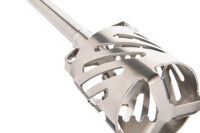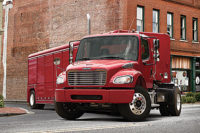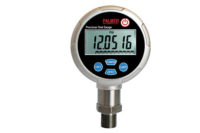Bag-in-box wine tap
Viniplus bag-in-box wine tap offers more than 100 days of shelf life extension. It has a high level of oxygen barrier protection that is four times the level of standard wine taps. The Viniplus closure is designed and manufactured by Worldwide Dispensers. The barrier membrane on the back on the Viniplus seals the area where the tap is affixed to the bag, which prevents air from entering the package at the bag’s most vulnerable point. The bag-in-box uses films that are fully recyclable and uses up to 80 percent less raw material and results in less waste. — Worldwide Dispensers USA, 78 Second Ave., South Lester Prairie, Minn. 55354; 320/395-2553; worldwide-dispensers.com.
Large character printer
Videojet Technologies Inc. introduced the 2320 large character ink jet printer. It provides high-resolution online printing of variable data on corrugated shipping containers for applications that require code heights from 0.8 to 2.7 inches. The printer has an automatic self-cleaning and self-maintenance system that continuously keeps printheads free of dust and debris. The printer recycles and reuses ink that was used during automatic printhead maintenance. The product also has an air-driven ink system that eliminates downtime due to maintenance on pumps, solenoids and other moving parts. — Videojet Technologies Inc., 1500 Mittel Blvd., Wood Dale, Ill. 60191; 630/616-3657; videojet.com.
Lightweight scanner
LXE Inc. introduced the 8650 Bluetooth Ring Scanner, a mobile device that can be used in a variety of supply chain environments. The lightweight 8650 ring scanner rests on the finger, with the Bluetooth module worn on the back of the hand or wrist. The module can transmit data from 30 feet away. It weighs 4.8 ounces, and the entire system is sealed to IP54 standards and can withstand multiple drops to concrete from up to 4 feet. Available in two scanning options, standard laser and 1D/2D imager, it has the battery power to operate for 24 hours, delivering up to 17,000 scans on a single charge. — LXE Inc., 125 Technology Parkway, Norcross, Ga. 30092; 770/447-4224; lxe.com.
Vending security system
Abloy Security Inc. introduced the Abloy Maximum Security Locking Solutions as well as the Shut-Out Series of vending security products at the National Automatic Merchandising Association Spring Expo. The hardened, free spinning protection plate prevents drill bits from penetrating the lock. The locks are key retaining, which prevents leaving the site before re-locking, and also are re-keyable in the event of key loss or theft. The Shut-Out line includes hasps, puck locks, the Shut-Out shield and safeguard. Shut-Out is designed to provide maximum security products for a complete vending security solution. — Abloy Security Inc., 6005 Commerce Drive, Ste. 330, Irving, Texas 75063; 800/367-4598; abloyusa.com.
Unbleached paperboard
MeadWestvaco Corp. offers KlaFold, a coated unbleached kraft paperboard manufactured by Klabin, Brazil’s largest paperboard producer. KlaFold has a three-ply structure for lightweight packaging applications. It offers a higher yield at the same caliper as most other coated paperboard in its class. KlaFold works on applications such as cosmetics, personal care products, frozen foods and electronics. It also is U.S. Food and Drug Administration and ISEGA compliant for direct food contact, and offers benefits of source reduction and FSC chain-of-custody certification. — MeadWestvaco, 11013 W. Broad St., Glen Allen, Va. 23060; 804/327-5200; meadwestvaco.com.
Frosty door decals
Visual Ice, a producer of frosty door decals, introduced advertisements that appear and disappear depending on the opening of the transparent door. The frosted message is seen up to 30 feet away and is visible as long as the door is open and several minutes after the door is closed, the company says. Visual Ice created a frosty door decal for Heineken USA’s Dos Equis beer on 1,050 cooler doors in marketplaces across the country. — Visual Ice Marketing, 5350 Twin Hickory Road, Glen Allen, Va. 23059; 972/989-8115; visualicemarketing.com.
Hybrid forklift
Komatsu Forklift U.S.A. Inc. introduced its hybrid electric forklift. The hybrid operates 11 hours per day with a one-hour opportunity charge during the shift. The technology uses a sealed, maintenance-free battery, built-in inverter charger, capacity and on-board charge controller to keep the truck running at peak performance. The truck has two energy sources from which the power is drawn: a capacitor and a sealed, maintenance-free, motive power industrial battery. It is currently available on the AE50, four-wheel pneumatic electric model family. The forklift has capacities of 3,000 to 35,000 pounds. — Komatsu Forklift U.S.A. Inc., 14481 Lochridge Blvd., Covington, Ga. 30014; 770/787-5100; kfiusa.com.
Workboard printer
Intermec introduced the PW50, a rugged workboard printer that provides an integrated solution to simplify operations for workers in direct store delivery, home delivery and field service applications. It is designed for use with the Intermec CN3, CN3e and CK61 handheld computers. The PW50 provides a single bundle that can be easily transported or installed in a vehicle. The printer has Bluetooth connectivity and has dual-charging capability that keeps both computer and printer batteries charged via a single electrical connection through the vehicle mount of a 12-volt adapter. It is currently shipping worldwide. — Intermec Inc., 6001 36th Ave. West, Everett, Wash. 98203; 800/347-2636; intermec.com.
Tradewinds switches to PET
Tradewinds Beverage Co., Cincinnati, grew by 1,400 percent in multipack sales for its ready-to-drink tea since converting from glass to PowerFlex PET bottles from Amcor PET Packaging, the company says. The company attributes the increase in sales to the lightweight and breakage-resistant features of the PET bottle. The single-serve PowerFlex bottles were commercialized by Tradewinds and made available in 2005 in convenience stores. In 2006, the company entered the club store channel with its more traditional glass multipacks, but this year, it converted those, too, to PowerFlex. It also added a six-count shrink-wrapped multipack and an eight-count PowerFlex multipack to mass merchandisers. “We had been studying sales patterns and could see that multipacks were the fastest growing segment for RTD iced teas,” said Steve Hatch, vice president of sales-FDM, Tradewinds Tea. “Although we had previously introduced glass bottles in a 12-count package, we felt that the time was right to convert to PET and add smaller multipack counts to address different consumer buying preferences between channels.” — Tradewinds Beverage Co., 635 W. Seventh St., Ste. 403, Cincinnati, Ohio 45203; 513/357-5225; tradewinds-tea.com.

Sanitizing solutions
Pacific Ozone’s mission is to develop solutions “for the benefit of people and the environment” through the use of ozone, which can be used for sanitization and disinfection, and also saves energy. Ozone is an oxidizer that kills common food-borne pathogens on both surfaces and in liquids. Ozone also benefits the environment because it works in cold temperatures, which saves energy, the company says.
Ozone is a triatomic version of oxygen using three oxygen atoms to form the ozone molecule (O3), says Bob Smith-McCollum, vice president of marketing. It is formed when energy from ultraviolet light or electrical discharge breaks the O2 bonds, forming single oxygen atoms that recombine with O2 molecules to form ozone.
The application of ozone within the beverage industry can be used in three ways. The first way is when ozone is injected into the water that comes into beverage plants to purify it before it goes through the bottling and filling process. The second is clean-in-place (CIP) systems in which ozone is used between runs to clean filling equipment. The third way ozone can be used is to sanitize bottled water. The ozone, acting as an oxidizer, sanitizes the finished product to eliminate the potential for contamination in the bottling process.
Pacific Ozone, once known as Pacific Technology, was founded by Peter Landgraf, inventor of a proprietary corona discharge reactor cell (Floating Plate Technology). In 1996, Brian and Karen Johnson acquired the company and realized that the FPT could take ozone to new levels. Brian Johnson invited Chris Rombach to join the company as president in 2006.
Making good water better
Ozone has the potential to be used in beverage plants before the filling process begins, Smith-McCollum says.
“Ozone can cause metals in the water to aggregate and that can remove iron and manganese,” Smith-McCollum says. “It can also remove odor that might be caused by hydrogen sulfide and organic compounds in the water. It breaks up organic molecules very easily — breaks them down into smaller components.”
Ozone currently is not being used by beverage processors for this purpose, but Smith-McCollum says he sees potential for ozone to “polish” incoming municipal water in a beverage plant before entering the production process.
“You get a certain quality from city water, but then you want to clean that up to make it even better,” he says. “Ozone can be a part of that process. It does a polishing effect where it removes tastes and odors really well.”
Rombach says beverages are one the greatest potential markets for ozone technology.
Clean that machine
Ozone also can be an important part of keeping a processing facility clean, Smith-McCollum says. It replaces hot water, steam and chemicals to save water, energy and time, he says.
Ozone also can be an important part of keeping a processing facility clean, Smith-McCollum says. It replaces hot water, steam and chemicals to save water, energy and time, he says.
Ozone is particularly useful in CIP systems, as well as clean-out-of-place and surface sanitization applications, Smith-McCollum says. It rinses and sanitizes simultaneously, which saves water.
One of the trends in the beverage industry is the proliferation of flavors, which requires a high level of cleaning between runs. Adding ozone to sanitization systems cleans tanks and lines faster and more effectively than traditional cleaning systems, Smith-McCollum says.
“Ozone-injected water can improve the effectiveness of CIP because it is a powerful oxidant that works well at reduced temperatures,” he explains. “High-temperature CIP processes require significant energy and time to ramp the entire system up to the target temperature and cool down at the end of the process. Ozone-injected water can replace chlorinated sanitizers, peracetic acid and hot water rinse in traditional CIP protocol.”
“There is a system of tanks and pumps and electronically controlled valves that pump different cleaners through the entire system in a loop and then returns it back to the tank,” he says. “Ozone can take the place of one of the last steps, which is the sanitizing step. The benefit is that it can sanitize and rinse the tank, the stainless steal transfer line and the piping at the same time.”
The company has installed technology for major beverage companies such as Pepsi, Coca-Cola, Cadbury Schweppes, Nestlé and DS Water.
Capping it off
The final step for ozone in beverage plants works for bottled water to purify the processed water. A low dose can be used to sanitize the bottle and eliminate anything that may have gotten into the water from air gaps in the filling process.
Ozone is a powerful disinfectant that carries no undesirable byproducts, Smith-McCollum says. It works faster than traditional sanitation technologies, has a broad application potential and is certified organic and kosher.
“Ozone reverts back to oxygen and it leaves no residue behind,” Rombach says. “You have no idea that ozone has been put into the system.”
“You wouldn’t ozonate a flavored product because [ozone] is a strong oxidizer so it’s going to kill the flavor and the color,” Smith-McCollum adds. “You can also take that ozonated processed water and you can use it to rinse bottles and caps.”
The ozone gas can be dissolved into water to form a naturally powerful oxidizing and disinfecting agent. Oxidation occurs when ozone molecules come in contact with oxidizable substances, including microorganisms.
Bottled water has a lengthy shelf life because injection of ozone is part of the process, Smith-McCollum says.
Rombach says one of the biggest challenges the company encounters is misinformation regarding ozone and how the system can be implemented.
“Ozone does do many things extremely well, but it does not do everything,” he says. “One of our primary missions is to simply educate and provide the right solutions.”
Smith-McCollum says that making sure the design of the ozone system is fully functional also is another challenge. The ozone system must integrate four elements: oxygen/feed gas preparation, ozone generation, dissolving the ozone into water and monitoring and controlling the system.
With the need for both effective sanitation and energy reduction, ozone is a system that beverage companies should be paying attention to, the company says.
“We believe that our ozone systems can improve sanitation efficacy while reducing the consumption of water, energy and chemical load,” Smith-McCollum says. “It can purify the processed water, it can be used to sanitize equipment and process systems and it can be used in bottled water for the final sanitization step in bottling. We’re very excited about the potential upside that we see in the beverage industry.” — Pacific Ozone Technology Inc., 610 Egret Ct., Benicia, Calif. 94510; 707/747-9600; pacificozone.com.


